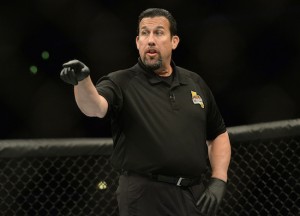Last week in Los Angeles, California State Athletic Commission Executive Director Andy Foster held a “Weight Cutting Summit” and this meeting went into details on potential changes when it comes to weight cutting in combat sports.

A recap of the entire meeting was done by Marc Raimondi of MMA Fighting, which I highly recommend reading. The story has quotes from UFC Vice President of Athlete Health and Performance Jeff Novitzky, MMA referee John McCarthy, and Association of Boxing Commission (ABC) President Mike Mazzulli.
Following the conclusion of the meeting, the major talking point with the media and the fans of the sport was the proposed new weight classes. The proposed weight classes were brought up by Sean Wheelock, who is a commissioner with the Kansas Athletic Commission and is the chairperson of the ABC MMA Rules and Regulations Committee.
Wheelock stated at the summit that the committee voted 9-0 with one abstention (this was due to this person being out of the country) that the new weight classes in MMA would be 115, 125, 135, 145, 155, 165, 175, 185, 195, 205, 225, 265 (heavyweight) and super heavyweight if they were approved. (Note: You can listen to Wheelock explain the proposed weight classes on the latest episode of The MMA Report Podcast).
At this point, this is just a proposed change and the next step is for the new weight classes to go in front of the Medical Committee. If that committee approves the weight classes, Mazzulli would send it to the Board of Directors of the ABC and then could potentially be voted on in August at the annual ABC meeting.
Now let’s just say the new weight classes get approved, it does not mean a promotion like the UFC would have to use them. Which is a key point to all of this. When the news of the proposed new weight classes came out, people jumped to conclusions that the UFC would have to adopt them. That is not the case and it brings me to the biggest quote from Raimondi’s article.
“The UFC doesn’t have to use a weight class,” McCarthy told MMA Fighting. “They don’t have to use the 170-pound weight class right now. They don’t use the 145-pound women. There’s weight classes they don’t utilize. They can do the same thing with any weight class they want. They’re a promotion and they have a right to say, ‘We don’t want to use this weight class.’ This is not about the UFC. This is about MMA. And there is MMA going on all over the world where we’ve got weight-cutting problems.”
The key comment in that quote is, “this is not about the UFC. This is about MMA.” What happened last week is very similar to what the UFC did earlier this year when they hired USADA to handle drug testing. The UFC wanted to change the culture of the sport, which a lot of people felt that fighters were not competing clean. What people like Mazzulli and Foster are trying to do is change the culture of extreme weight cutting.
I can understand why fans may not be on board with some of the weight classes, mainly the 225 pound weight class. However, this is about changing the culture of the sport and most importantly, fighter safety. If you are against adding a 225 pound weight class to MMA, are you against fighter safety?
Saying all of that, the major conclusion I draw from last week’s meeting in California is this. For the first time in a long time, the ABC is relevant again. Under the direction of Mazzulli, the ABC is looking to make changes to the sport. No disrespect to the previous regime of the ABC, but the new regime has done more in four months to improve this sport than the previous regime did in their eight years running the ABC. For someone who has been reporting on this sport for over seven years, it’s great to see that the ABC is once again relevant.
